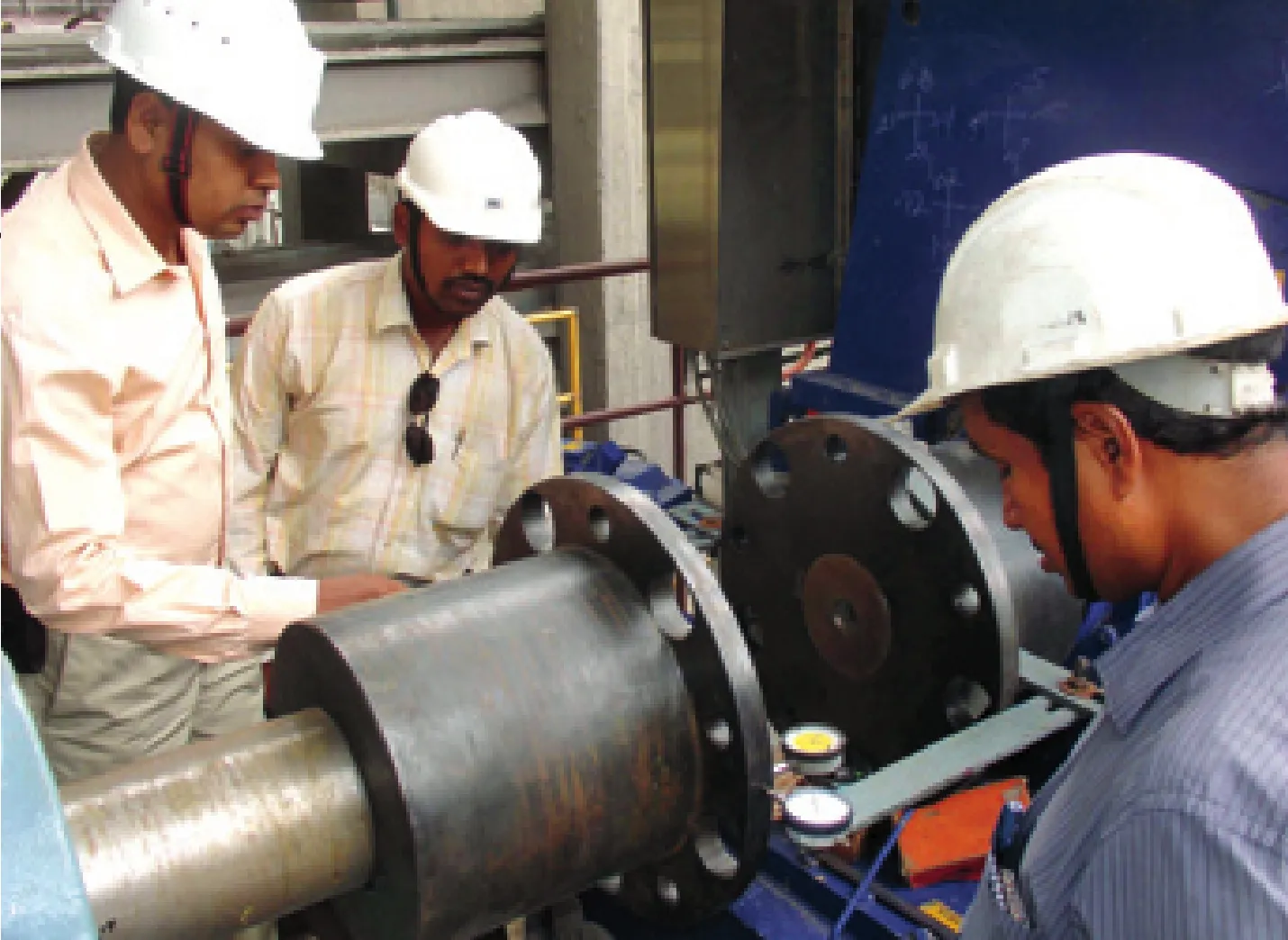Bureaucratic Obstacles
2012-10-16YuLintao
Bureaucratic Obstacles
Visa hassles and other red tape hamper Chinese investment in India By Yu Lintao

INAUGURATION: Chinese and Indian o fficials attend the inauguration ceremony o f a p lant o f the Chinese construc tion m achinery manufacturer Sany Heavy Industries in Maharashtra, India on April 12, 2010
Z hao Quanzhen is leaving India, and w ith it a career that he now questions.After working in the country for more than seven years, Manager of Air China’s India Office, worries about the profit outlook of his past station despite more and more new routes being added between China and India.
Since Zhao was sent to Mumbai for the opening of a new flight route linking China and India in 2004, the number of routes operated by Air China between the two countries has quickly increased. There are now more than 20 fl ights a week.
“Almost all Indian states want us to establish direct fl ight routes from Chinese cities to Indian cities,” Zhao said.
Despite big market potential as China and India rise simultaneously, the former manager remains cautiously pessim istic.
“It’s very hard to make profi ts when operation costs are skyrocketing due to rising oil prices and the various taxes imposed,” said Zhao.
More importantly, he added, the number of Chinese passengers going to India is limited. His sentiment is supported by data on the airline’s passenger demographics. Of all passengers on the China-India route, less than 30 percent are Chinese nationals.
Trave l w oes
Statistics from the Chinese Embassy in New Delhi show 600,000 to 700,000 Indians travel to China annually while only 60,000 to 70,000 Chinese make trips to India.
“Besides Chinese people’s preference to visit different tourist destinations in outbound travel,a major reason why there are fewer Chinese people going to India is India’s tough restrictions on visas for the personnel of Chinese companies entering India,” said Lou Chunhao, a researcher on South Asian studies with the China Institutes of Contemporary International Relations.
Despite a $27-billion trade deficit in China’s favor last year, Indian companies in China far outnumber Chinese companies in India due to the tough restrictions.
Chinese businessmen complain about the application procedures to get a visa to India,w ith some having to supply an exorbitant number of documents while others are made to wait a long time.
Zhao has had his own wearisome experiences w ith visa problems. “It is very hard to get work visas. During my fi rst few years in India, I was holding a business visa, so I had to leave the country every three to six months to renew it,” Zhao said. And early this year, Zhao’s finance director had to wait two months to renew his visa before returning to his office in New Delhi, disrupting business and causing annoyance for the staff.
“The office almost ceased to function during that period when I could not find a suitable substitute,” Zhao said.
Lou said the visa problem is partly the outcome of inadequate political trust of India toward China, as well as India’s employment protection policies.
“Bilateral relations have made much progress and the two countries have gotten closer and closer in the last two decades, but still India is wary of China for historical reasons,” said Lou.
Information from the Indian M inistry of Home A ffairs reveals that China, along w ith Pakistan, Bangladesh, Sri Lanka, Bhutan,Afghanistan and Nepal, is on a list of specified countries that the Indian Government imposes tougher visa application standards on.
Lou said academics meet the same problems.
“Sometimes, our Indian counterparts prefer to hold international academic conferences in a neutral country in case the attendees cannot get Indian visas,” said Lou.
India’s restricted visa policy is part of its policies on domestic employment protection,said Lou. Work and project visas to India are more difficult to get, which affects Chinese companies’ investment in India.
Some Chinese construction companies complained that, due to visa difficulties, many technicians were unable to reach construction sites in time and the completion of their projects was often delayed.
“In fact, those Chinese projects could generate a large number of jobs for local Indian people, especially those concerning infrastructure construction,” Lou said.
The chief representative of a Chinese power construction firm’s Delhi office who asked to remain anonymous because of the sensitiveness of the visa issue toldBeijing Reviewthat most of their onsite employees are local people and more than 50 percent of the managerial staff are Indians, including translators, human resources directors, financial officers and deputy project managers.

LOCALIZATION: Local em p loyees in India w ork on a p ro jec t o f SEPCO III, a Chinese com pany specializing in build ing power p lants
“There are great opportunities for Chinese construction enterprises as India is conducting large-scale infrastructure construction. Its annual budget on infrastructure construction this year is $27.7 billion. Meanwhile, China has rich experience in the field as well as advantages in construction technology and machinery,” said Lou.
According to India’s 12th Five-Year Plan(2012-17), it w ill invest $1.2 trillion in infrastructure construction over the next five years.
Com p lem en tary econom ies
Lou said given their different development models, China and India have many complementary aspects to each other’s econom ic development. Close cooperation between the two will benefi t both countries, in construction as well as other industries. W ith an enormous labor force, India is one possible destination for China’s labor-intensive industries as China restructures its domestic economy.
“Take the textile industry as an example,”Lou said. “China has technological and machinery advantages while India is rich in raw textile materials and low-cost labor. Chinese textile producers could invest in India for better development.”
“M eanwhile, India has advantages in information technology, service industry andbiological pharmacy. Indian companies in these fields can develop their potential in the Chinese market,” he added.

Sino-Ind ian Trade
Some Indian econom ic observers hold similar views. Mohammed Saqib, Secretary General of the India China Economic and Cultural Council, said as China’s labor cost continues to rise, Chinese enterprises moving to India may find space for development.India should learn from China’s experience in the last three decades by seizing the chance of industrial transfer among the emerging Asian countries. Currently, China is upgrading its industries and India should attract more Chinese enterprises to invest in India, Saqib said.
“On the international scene, we look at how these two merging countries are doing.China is the factory of the Earth, and India’s grow ing service sector is a powerhouse,” said Anwarul Hoda, Chair Professor of the Trade Policy and WTO Research Program at the Indian Council for Research in International Econom ic Relations. “But we do have to boost the manufacturing sector to provide good jobs to our hundreds of m illions of people in the next decade.”
However, despite the huge potential for cooperation between the two countries, obstacles like the visa issue still exist. For India,a major point of concern is the large bilateral trade deficit in China’s favor in recent years,which may add fuel to protectionism in India.
“The trade imbalance between the two countries is due to structural reasons,” said Lou.“Before 2006, the bilateral trade imbalance was in favor of India. But now, China has advantages in the manufacturing industry such as heavy machinery equipment and electronic equipment.These products have higher added value than iron ore, which accounts for about 60 percent of India’s exports to China.”
“The problem should be resolved gradually through economic development,” Lou added.
